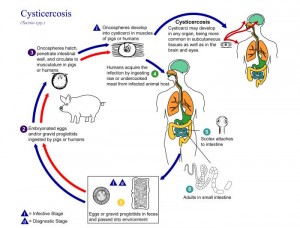Zoonoses are diseases that can be passed from animals to humans and vice versa, and they cover a broad range of diseases with different clinical and epidemiological features and control measures. The causative organism may be viral, bacterial, fungal, protozoal, parasitic or any other contagious agent. Farm staff and visitors should follow hygienic precautions to minimise risk of spread.
Zoonotic infections in man can be transmitted by a variety of routes, such as in food, water, person to person, animal to person, indirect contact through clothing, equipment, and through insect or animal vectors.
In the UK zoonotic diseases are often notifiable or reportable to the APHA because of the related public health risk.
Zoonotic cattle diseases covered in Farm Health Online include:
- Bovine Spongiform Encephalopathy
- Bovine Tuberculosis
- Brucellosis
- Calf Diarrhoea
- Campylobacteriosis
- Cryptosporidiosis
- Leptospirosis
- New Forest Eye
- Ringworm
- Rotavirus and Coronavirus
- Salmonellosis

By http://www.dpd.cdc.gov/dpdx/images/ParasiteImages/S-Z/Taeniasis/Taenia_LifeCycle.gif, Public Domain, https://commons.wikimedia.org/w/index.php?curid=776789
Pig zoonoses
Neurocyctercercosis or brain damage in humans (DeGiorgio et al., 2004), which may be endemic in many low income countries (Garcia et al., 2014) which results from the accidental ingestion of eggs of Taenia solium, possibly from the consumption of under-cooked meat from pigs that have consumed human faeces infested with Taenia soleum (tapeworm).
Pigs and wild animals infected with the roundworm Trichinella can pass this to humans causing the painful condition trichinosis. Hygiene and meat inspection rules ensure that there is only very low prevalence in Europe and US (Gottstein et al., 2009), although globally this can cause widespread suffering e.g. Akkoc et al. (2009).


 American English
American English


Comments are closed.